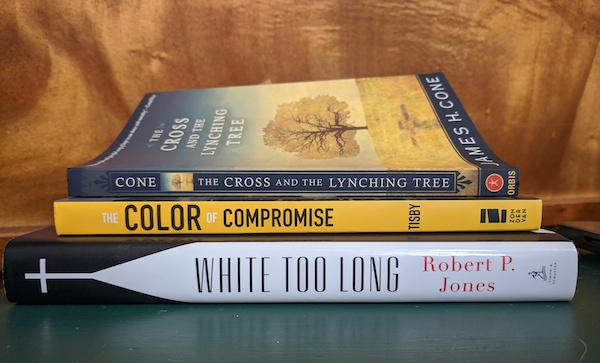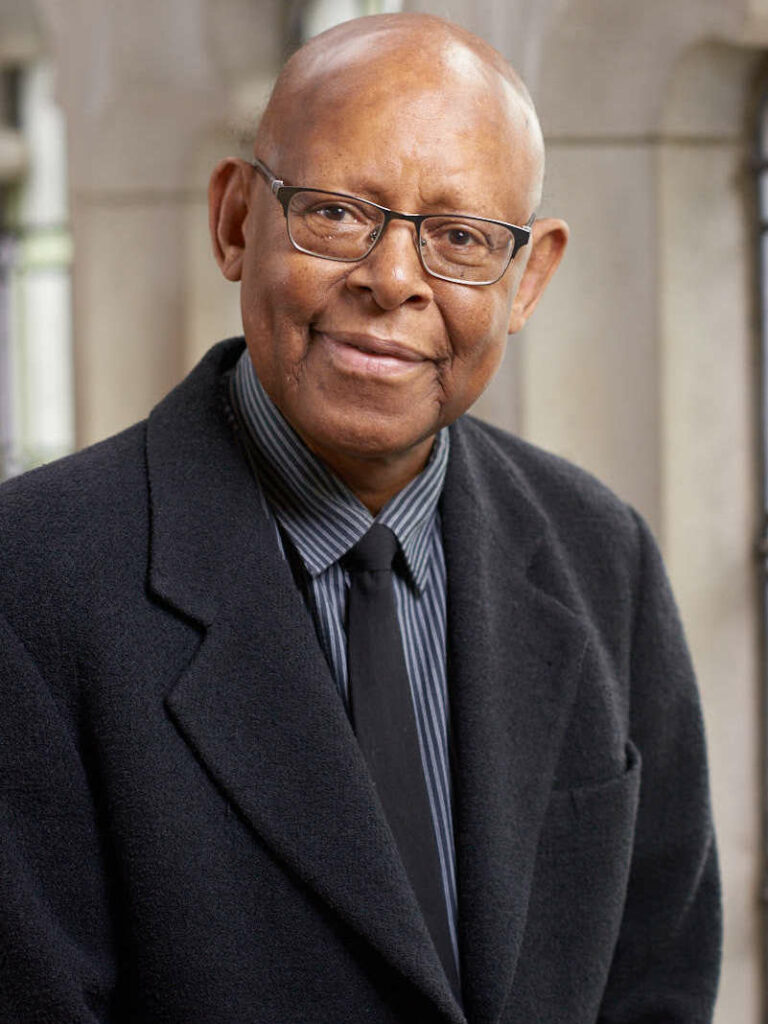The Cross and the Lynching Tree, James H. Cone (2011)
The Color of Compromise: The Truth about the American Church’s Complicity in Racism, Jemar Tisby (2019)
White Too Long: The Legacy of White Supremacy in American Christianity, Robert P. Jones (2020)
“The cross and the lynching tree are separated by nearly 2,000 years. One is the universal symbol of Christian faith; the other is the quintessential symbol of black oppression in American. Though both are symbols of death, one represents a message of hope and salvation, while the other signifies the negation of that message by white supremacy. Despite the obvious similarities between Jesus’ death on a cross and the death of thousands of black men and women strung up to die on a lamppost or tree, relatively few people, apart from black poets, novelists, and other reality-seeing artists, have explored the symbolic connections. Yet, I believe this is a challenge we must face. What is at stake is the credibility and promise of the Christian gospel and the hope that we may heal the wounds of racial violence that continue to divide our churches and our society.” James H. Cone, The Cross and the Lynching Tree, pp. xiii-xiv
“History and Scripture teaches us that there can be no reconciliation without repentance. There can be no repentance without confession. And there can be no confession without truth. The Color of Compromise is about telling the truth so that reconciliation—robust, consistent, honest reconciliation—might occur across racial lines. Yet all too often, Christians, and Americans in general, try to circumvent the truth-telling process in their haste to arrive at reconciliation. This book tells the truth about racism in the American church in order to facilitate authentic human solidarity.” Jemar Tisby, The Color of Compromise, p. 15
“This book puts forward a simple proposition: it is time—indeed, well beyond time—for white Christians in the United States to reckon with the racism of our past and the willful amnesia of our present. Underneath the glossy, self-congratulatory histories that white Christian churches have written about themselves is the thinly veiled, deeply troubling reality. White Christian churches have not just been complacent; they have not only been complicit; rather, as the dominate cultural power in American, they have been responsible for constructing and sustaining a project to protect white supremacy and resist black equality. This project has framed the entire American story.” Robert P. Jones, White Too Long, pp. 5-6

This is a compelling trio of books from accomplished thinkers, scholars, and writers that ask hard questions of the American church about its history of White supremacy, its neglect of the centrality of human suffering to Jesus’s ministry and death, and its active use of, tacit endorsement of, and shameful silence in the face of violence and discrimination against Black men, women, and children throughout American history.
Theologian James H. Cone wrote a number of influential books about theology and ethics before his death in 2018. The Cross and the Lynching Tree was the last of these. He writes in his introduction that he did not want to research, examine, and write about or sit with the horrifying facts of lynching any more than White America wants to face its history of lynching from 1880 to 1940. The subject is painful, shameful, and illuminating. Cone explores the comfort and inspiration that Black preachers drew for slaves and later free Black Americans from the suffering and murder of Jesus on the tree of crucifixion and the undeniable historical and theological parallels between the use of crucifixion by the Romans to punish, terrorize, and discourage uprising in First Century Palestine and the use of lynching by White mobs to punish and control free Black men, women, and children and to terrorize Black communities throughout the Jim Crow era. He wonders whether an inability or unwillingness to empathize with the horrific realities faced by Black America prevented White preachers and theologians from embracing these parallels and opposing lynching in the many years it was commonly practiced. Cone proposes that White Americans cannot embrace and absorb the same lessons that Black Americans have taken from the life of Jesus and his alignment with the least of these because White Christians lacked the same experience of marginalization and violence that Black Christians and Black communities share with the First Century Jewish Palestinians Jesus taught, healed, served, and walked among in the New Testament.

In this primer on the Black theology of suffering and redemption, James Cone offers a history of the blues, spirituals, poetry, and other art as protest against the violence of racism and lynching for catharsis without the direct confrontation that would attract a violent backlash. He contrasts the work and writings of Reinhold Niebuhr, who did not address the suffering of Black Americans despite his theological focus on justice, with that of Dietrich Bonhoeffer, whose experiences with Naziism gave him a lens for seeing the suffering of the Black community when he visited the U.S., and Martin Luther King, Jr., who used the plight of Black America and the story of the suffering, death, and resurrection of Jesus to wrestle with the “challenge of persistent and deep suffering” (Cone at 89) while neither legitimizing suffering nor absolving those who inflict suffering. Cone continues his examination of lynching and the cross by examining the Black literary tradition around lynching and by commemorating Black women who were victims of lynching and activists against lynching. His book asks us to reflect on whether our own theology brings us into empathy and alliance with those who suffer or lets us sit in comfort with ignoring suffering, to our own moral detriment.
“His book asks us to reflect on whether our own theology brings us into empathy and alliance with those who suffer or lets us sit in comfort with ignoring suffering, to our own moral detriment.”
Jemar Tisby and Robert Jones show us how White Christians have understood, embraced, and lived out the story of racism over time and how we understand and live out the story of racism in America today. Tisby’s focus is history-based and forward-looking, while Jones uses history but also weaves in public opinion survey data from his research organization, the Public Religion Research Institute (PRRI) to give us a present-day snapshot of White Christian attitudes. These two spotlights on the roots and the continuing realities of racism in the White American church are a call to honest self-reflection and action for individuals, leaders, congregations, and denominations alike.

What Ibram X. Kendi does to survey the history of racist thought in Stamped from the Beginning, Tisby does in The Color of Compromise, but with his historical spotlight focused hard on the American church. Tisby opens his book with the September 15, 1963, bombing of Sixteenth Street Baptist Church in Birmingham, Alabama. That horrific attack that killed four girls and injured twenty other people is just one example he gives of how “American Christians have collaborated with racism for centuries.” (Tisby, p. 15) He reviews each period in American history for its racial ideological developments and the corresponding complicit actions of individual Christians and Christians churches of the time. His historical survey begins with Columbus “discovering” North America in 1492 and the opinions he sent home of how suitable the indigenous people would be for servitude to European settlers. He highlights the ties between missionary efforts and White supremacist ideology and theology from the beginnings of the American colonies.
He reviews the Middle Passage, the role prominent Christian people played in the slave trade, the first group of African slaves to be brought to continental North America in 1619, and the comfort White Christians developed with both the brutality of slave owning and the legalizing of dehumanization through the slave codes. One notable colonial moment was a vote by the largely Anglican Virginia General Assembly in Williamsburg affirming that baptism would not make a slave free, so that slaveholders need not fear that “civilizing” their slaves through Christian conversion would go against their own economic interests. White Christians during Revolutionary times and the antebellum and Civil War periods (including the splits in the Methodist and Baptist churches over slavery and whether slaveowners could be commissioned as missionaries), all receive his well-deserved scrutiny and criticism. In the post-Civil War period, he identifies the churches and the theology that nursed the Lost Cause narrative, birthed the Ku Klux Klan and animated its rhetoric, celebrated Confederate Memorial Day, raised funds for memorials to be erected in the height of the Jim Crow era, barred access to the voting booth for Black citizens, and failed to speak against or oppose the use of lynching as a way to control the Black population through terror and fear. His examples of White church complicity with racism extend into the New Deal era, the post-WWII-era, and the Civil Rights movement, the Nixon, Reagan, and Obama administrations and the rise of the Religious Right in politics. He makes a compelling case that the White church has a deep-seated and longstanding acquaintance with and responsibility for propping up and abetting racism that affects its identity and witness in the world today.
“The White church has a deep-seated and longstanding acquaintance with and responsibility for propping up and abetting racism that affects its identity and witness in the world today”
Jones takes a different approach from Tisby. He begins with a recent snapshot of White church involvement with extreme right-wing politics of the White supremacist variety and looks backward to trace what he calls the “DNA of white supremacy in America” through the history of the church and of American Christian thought. He provides snapshots of various eras and thinkers in American history that encapsulate White Christian complicity in systemic racism. Tisby and Jones both give us an orientation to the roots of two divergent strains of Christian theology in the American church that affect what churches prioritize: the social gospel and fundamentalism, which have their roots shortly after the turn of the Twentieth Century. While his historical treatment is not as painstaking as Tisby’s, Jones incorporates survey data about current racial attitudes among American Christians that provides a damning snapshot of where we are today.

Chapter 5 of his book, “Mapping”, tracks through statistical analysis of survey data the incidence of racist attitudes among present-day White Christians by both geography (with particular emphasis on former slaveholding regions) and by religious affiliation. Compellingly, he concludes that White evangelical Protestants report the warmest feelings towards African Americans of any other group but also score highest on the racism index that reflects the individual’s racist and racially resentful attitudes. He explores the implications of the disconnect between what people of faith believe about race and what they believe they believe about race. He concludes his books with “stories of change” about congregations that are taking deliberate steps to reach across racial lines and overcome their historic legacies of racism. He discusses what personal exploration of these issues and reconciliation on an individual and institutional level must look like for the American church.
Taken together, these three important books give a multi-faceted, multi-disciplinary introduction to where the church in America has been, how it conceptualizes its relationship to society and its role in addressing racism, and how and where it can pivot to fuller truth, empathy, and engagement with the plight of marginalized people.
James H. Cone was a minister, theologian, and professor of theology at Union Theological Seminary. He wrote and published many influential books on the Black experience, the Black church, Black theology and politics, and liberation theology. Along with numerous lectures and other interviews available online, Cone spoke with Bill Moyers about The Cross and the Lynching Tree in 2013.
Jemar Tisby is a minister, an historian, a Ph.D. candidate, the founder and CEO of The Witness, Inc., and a host of the Pass the Mic podcast, as well as a speaker and bestselling author. His newest book, How to Fight Racism: Courageous Christianity and the Journey Toward Racial Justice, published in January 2021, develops concepts introduced in the concluding chapter of The Color of Compromise. It is a handbook for the ARC of Racial Justice framework that teaches readers how to develop the awareness, relationships, and commitment needed to work for and orient one’s life to racial justice and fighting systemic racism. He has numerous video and podcast interviews available online. His publisher, Zondervan, has made courses based on both of his books available on YouTube, as well.
Robert P. Jones founded and leads the Public Religion Research Institute, writes a column for The Atlantic, and is the author of a previous book, The End of White Christian America. His numerous interviews related both to his books and to his work at PRRI are available on YouTube.































